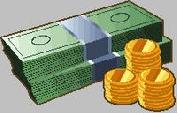
 |
|
| Financial Terms | |
| Formalized Line of Credit |
|
Information about financial, finance, business, accounting, payroll, inventory, investment, money, inventory control, stock trading, financial advisor, tax advisor, credit.
Main Page: payroll, investment, financial, finance, credit, inventory, financial advisor, business, |
Definition of Formalized Line of Credit
Formalized Line of CreditA contractual commitment to make loans to a particular borrower up to a specified maximum during a specified period, usually one year.
Related Terms:Bank lineline of credit granted by a bank to a customer. Best-interests-of-creditors testThe requirement that a claim holder voting against a plan of reorganization Capital market line (CML)The line defined by every combination of the risk-free asset and the market portfolio. Cash flow time-lineline depicting the operating activities and cash flows for a firm over a particular period. Characteristic lineThe market model applied to a single security. The slope of the line is a security's beta. Comparative credit analysisA method of analysis in which a firm is compared to others that have a desired Consumer creditcredit granted by a firm to consumers for the purchase of goods or services. Also called  CreditMoney loaned. Credit analysisThe process of analyzing information on companies and bond issues in order to estimate the Credit enhancementPurchase of the financial guarantee of a large insurance company to raise funds. Credit periodThe length of time for which the customer is granted credit. Credit riskThe risk that an issuer of debt securities or a borrower may default on his obligations, or that the Credit scoringA statistical technique wherein several financial characteristics are combined to form a single Credit spreadRelated:Quality spread Crediting rateThe interest rate offered on an investment type insurance policy. CreditorLender of money.  Demand line of creditA bank line of credit that enables a customer to borrow on a daily or on-demand basis. Euro lineslines of credit granted by banks (foreign or foreign branches of U.S. banks) for Eurocurrencies. EurocreditsIntermediate-term loans of Eurocurrencies made by banking syndicates to corporate and Evergreen creditRevolving credit without maturity. Federal credit agenciesAgencies of the federal government set up to supply credit to various classes of Five Cs of creditFive characteristics that are used to form a judgement about a customer's creditworthiness: Foreign tax creditHome country credit against domestic income tax for foreign taxes paid on foreign Full faith-and-credit obligationsThe security pledges for larger municipal bond issuers, such as states and Investment product line (IPML)The line of required returns for investment projects as a function of beta Investment tax creditProportion of new capital investment that can be used to reduce a company's tax bill Letter of credit (L/C)A form of guarantee of payment issued by a bank used to guarantee the payment of  Line of credit An informal arrangement between a bank and a customer establishing a maximum loan Linear programmingTechnique for finding the maximum value of some equation subject to stated linear constraints. Linear regressionA statistical technique for fitting a straight line to a set of data points. Log-linear least-squares methodA statistical technique for fitting a curve to a set of data points. One of the Line of creditAn informal arrangement between a bank and a customer establishing a maximum loan Mortgage pipelineThe period from the taking of applications from prospective mortgage borrowers to the Mortgage-pipeline riskThe risk associated with taking applications from prospective mortgage borrowers Old-line factoringFactoring arrangement that provides collection, insurance, and finance for accounts receivable. Retail creditcredit granted by a firm to consumers for the purchase of goods or services. Revolving credit agreementA legal commitment wherein a bank promises to lend a customer up to a Revolving line of creditA bank line of credit on which the customer pays a commitment fee and can take Security characteristic lineA plot of the excess return on a security over the risk-free rate as a function of Security market lineline representing the relationship between expected return and market risk. Simple linear regressionA regression analysis between only two variables, one dependent and the other explanatory. Simple linear trend modelAn extrapolative statistical model that asserts that earnings have a base level and Straight line depreciationAn equal dollar amount of depreciation in each accounting period. Swingline facilityBank borrowing facility to provide finance while the firm replaces U.S. commercial paper Trade creditcredit granted by a firm to another firm for the purchase of goods or services. STRAIGHT-LINE DEPRECIATIONA depreciation method that depreciates an asset the same amount for each year of its estimated CreditBuying or selling goods or services now with the intention of payment following at some time in CreditorsPurchases of goods or services from suppliers on credit to whom the debt is not yet paid. Or a Line itemGeneric types of assets, liabilities, income or expense that are common to all businesses and CreditOne side of a journal entry, usually depicted as the right side. Straight-lineA method of depreciation. bottom lineA commonly used term that refers to the net income (profit) net income (also called the bottom line, earnings, net earnings, and netoperating earnings) straight-line depreciationThis depreciation method allocates a uniform Security Market LineA graph illustrating the equilibrium relationship between the line employeean employee who is directly responsible for linear programminga method of mathematical programming used to solve a problem that involves an objective function and multiple limiting factors or constraints long-term variable cost a cost that was traditionally viewed as a fixed cost Management Accounting Guidelines (MAGs)pronouncements of the Society of Management Accountants of product line marginsee segment margin red-line systeman inventory ordering system in which a red regression lineany line that goes through the means (or averages) of the set of observations for an independent variable and its dependent variables; mathematically, there is a line of âbest fit,â which is the least squares regression line timelinerepresentation of the amounts and timing of all credit analysisProcedure to determine the likelihood a customer will pay its bills. credit policyStandards set to determine the amount and nature of credit to extend to customers. line of creditAgreement by a bank that a company may borrow at any time up to an established limit. security market lineRelationship between expected return and beta. straight-line depreciationConstant depreciation for each year of the assetâs accounting life. Credit CrunchA decline in the ability or willingness of banks to lend. Credit RationingRestriction of loans by lenders so that not all borrowers willing to pay the current interest rate are able to obtain loans. 45-Degree LineA line representing equilibrium in the goods and services market, on a diagram with aggregate demand on the vertical axis and aggregate supply on the horizontal axis. Investment Tax CreditA reduction in taxes offered to firms to induce them to increase investment spending. Consumer Credit Protection ActA federal Act specifying the proportion of Other-than-Temporary Decline in Market ValueThe standard used to describe a decline in market value that is not expected to recover. The use of the other-than-temporary description as Creditor Proof ProtectionThe creditor proof status of such things as life insurance, non-registered life insurance investments, life insurance RRSPs and life insurance RRIFs make these attractive products for high net worth individuals, professionals and business owners who may have creditor concerns. Under most circumstances the creditor proof rules of the different provincial insurance acts take priority over the federal bankruptcy rules. CreditA rating of a company's credit (ability to payback debt), usually by a third party credit agency. Credit LossA loan receivable that has proven uncollectible and is written off. Credit RiskFinancial and moral risk that an obligation will not be paid and a loss will result. Credit TermsConditions under which credit is extended by a lender to a borrower. Credit Unioncredit unions are community based financial co-operatives and most offer a full range of services. All are owned and controlled by members who are also shareholders. credit unions are regulated provincially and insured by a stabilization fund, deposit insurance or guarantee corporation. CreditorPerson or business that is owed money. Export Credit InsuranceThe granting of insurance to cover the commercial and political risks of selling in foreign markets. Full Credit PeriodThe period of trade credit given by a supplier to its customer. Letters of CreditA letter of credit is a guarantee of payment by a bank (issuing institution)to a third party for a specific amount of money, if certain conditions are met. Line of CreditAn agreement negotiated between a borrower and a lender which establishes the maximum amount against which a borrower may draw. The agreement also sets out other conditions, such as how and when money borrowed against the line of credit is to be repaid. Operating Line of CreditA bank's commitment to make loans to a particular borrower up to a specified maximum for a specified period, usually one year. Revolving Creditline of credit against which funds may be borrowed at any time, with regular scheduled repayments of a predetermined minimum amount. Supplier CreditPeriod of delay allowed by a firm's supplier to pay its invoices. Frequently, the terms are : 2% discount on invoice if paid in 10 days or net if paid in 30 days. creditOn your bank statement, 'credit' represents funds that you have deposited into your account. The opposite of a credit is a debit. credit bureauAn organization that provides financial institutions with credit information concerning existing or potential customers who are looking to obtain credit services. credit cardA revolving source of credit with a pre-established limit. You have to pay interest on a credit card if you have an outstanding balance. credit memoA record of the funds which have been credited to your account. line of creditA revolving source of credit with a pre-established limit. You access the funds only as you need them, and any amount that you pay back becomes accessible to you again. Unlike a personal loan, a line of credit permits you to write cheques and make bank machine withdrawals, and requires you to pay interest only on the funds that you actually use. online bill paymentThe electronic payment of a bill via the Internet. The specified amount of the bill is electronically debited from your account. personal line of credit (PLC)A revolving source of credit with a pre-established limit. You access the funds only as you need them, and any amount that you pay back becomes accessible to you again. Unlike a personal loan, a PLC permits you to write cheques and make bank machine withdrawals, and requires you to pay interest only on the funds that you actually use. secured loan or line of creditA lump sum of funds (loan), or a revolving source of credit with a pre-established limit (line of credit), for which the customer must provide collateral. Accidental Dismemberment: (Credit Insurance)Provides additional financial security should an insured person be dismembered or lose the use of a limb as the result of an accident. Amortization (Credit Insurance)Refers to the reduction of debt by regular payments of interest and principal in order to pay off a loan by maturity. Beneficiary (Credit Insurance)The person or party designated to receive proceeds entitled by a benefit. Payment of a benefit is triggered by an event. In the case of credit insurance, the beneficiary will always be the creditor. Borrower (Credit Insurance)A consumer who borrows money from a lender. Related to : financial, finance, business, accounting, payroll, inventory, investment, money, inventory control, stock trading, financial advisor, tax advisor, credit. |